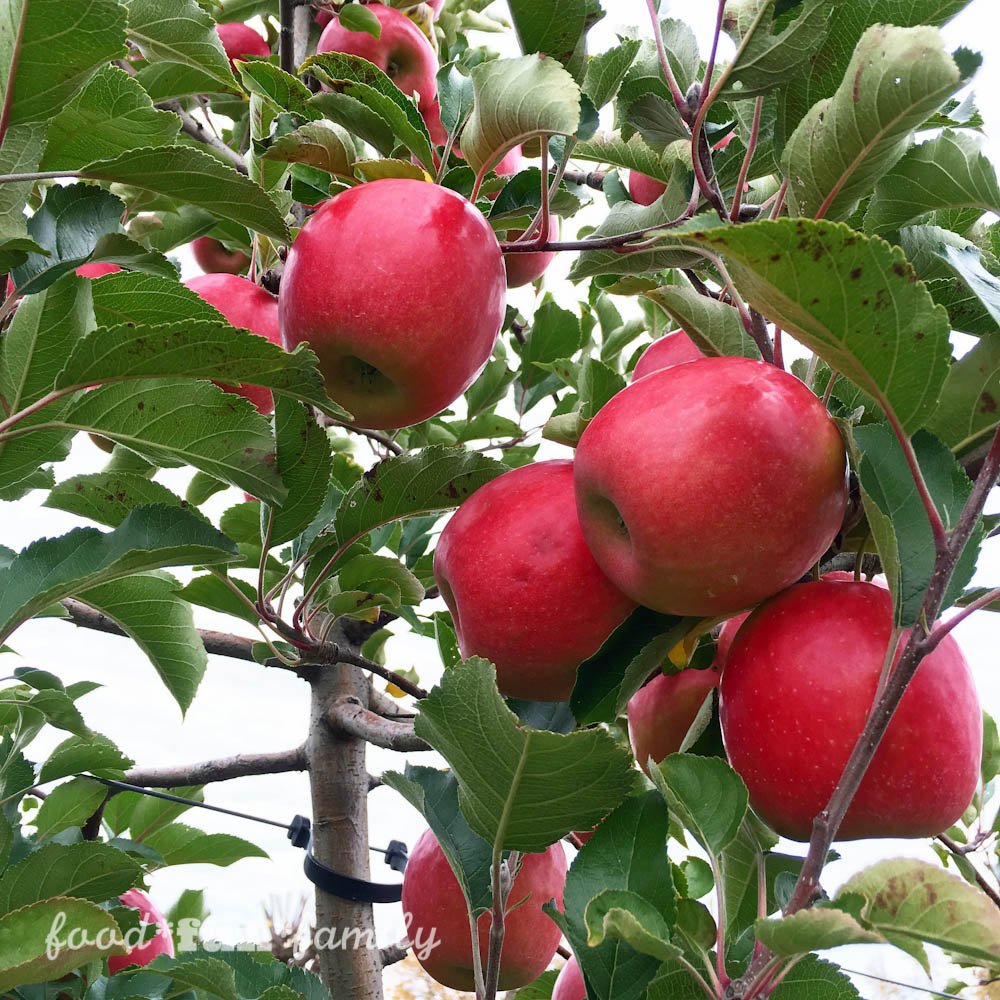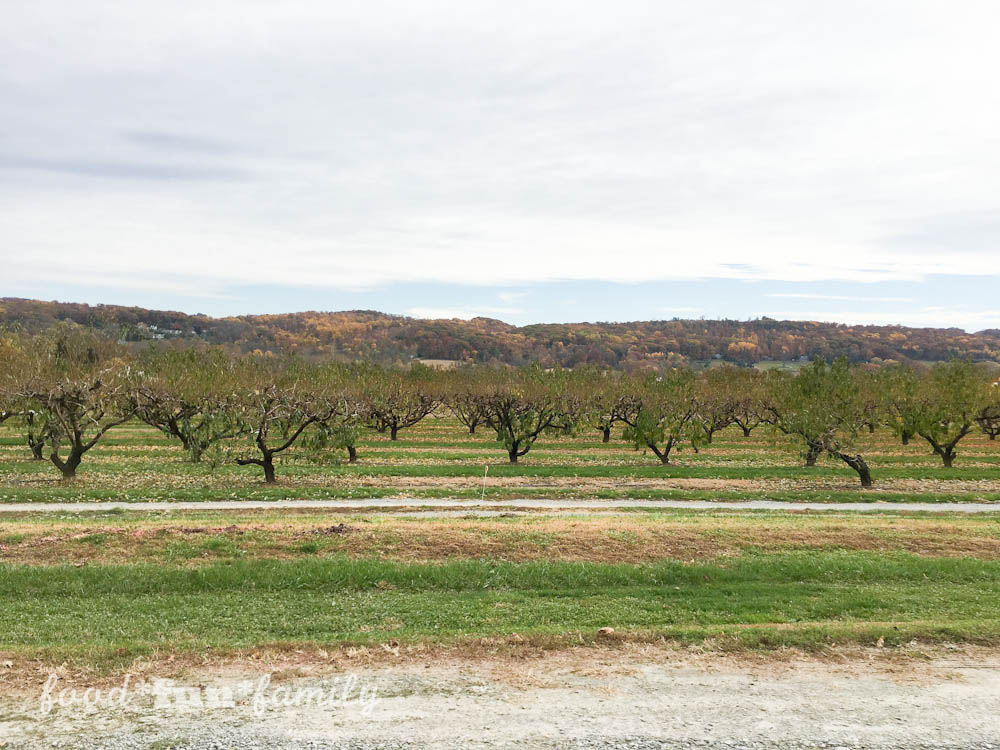How often do you get to see what real farming looks like? For a girl from the suburbs like me, that’s not too often. I love when blogging affords me the opportunity to have meaningful, teachable moments with my kids…and our visit to Flinchbaugh’s Orchard and Farm was a wonderful opportunity for all of us.
When I was at Blogalicious in September, I met a few local farmers who were there to chat with conference attendees about sustainable farming practices and their association with Monsanto. In October, one of the farmers that I met invited my family out to their farm in Pennsylvania for a real hands-on, back-end look at how their farm and orchard work and how farming has changed in the last 70 or so years since their family has been farming this land. I got to sit down and have lunch with Julie, the youngest of the Flinchbaugh family, and her husband. In fact, the kids and I got to spend all day talking with them, following them around the farm and orchard, where we finally got to pick some Pink Lady apples from the last of the fruit-bearing trees. Although some travel expenses were covered, all thoughts and photos are my own. I’ll apologize upfront for the sheer number of photos. It was such a gorgeous day, I just couldn’t help it!
Julie’s story (and the story of her family’s farm) fascinated me. She is the youngest child of Sonia and Ritchie Flinchbaugh (she’s got 2 older brothers, Andrew and Michael). Ritchie grew up on the farm (his parents started farming the land in 1951), and his mom, Louise, still lives on the farm and we saw her working in the farm market while we were looking around. We were even able to meet one of the younger generation – my son got to help one of Andrew’s sons shovel corn feed (he LOVED it!).
This post has taken me a long time to write simply because we learned so much (and so much NEW-to-me info). I told my kids that it felt like we were on a day-long family field trip…and it was true. We were IN the fields. At first I was worried that the older girls would be bored, but the information that Julie, plus her husband and brothers, told us was so fascinating all of us were sad to have to leave at the end of the day.
About Flinchbaugh’s Orchard and Farms
- Flinchbaugh’s Orchard and Farms encompasses nearly 420 acres of land, where they farm produce crops and orchard fruits, and is maintained by three generations of Flinchbaughs.
- An additional 1300 acres of leased ground is cropped with corn, soybeans, wheat and hay.
- The Farm Market, finished in 2006, has 8,000 square feet of sales area, additional operating facilities and a picnic pavilion which allows the Flinchbaughs to connect provide opportunities for educational activities to connect the public with their food sources.
- Ritchie & Sonia’s three children – Mike, Andrew & Julie – each graduated from Penn State and then decided to return to work in the family business after graduation.
Sustainable Practices at Flinchbaugh’s Orchard and Farms
We learned how important conservation is to the Flinchbaugh family at all levels – water, land, energy and environmental resources. They conserve water through a drip irrigation system (the kids loved seeing how that worked in the orchards) and they practice Integrated Pest Management techniques to cut back on the amounts of pesticides needed.
We loved seeing how the no till method works and WHY no till farming is the way to go now. Mike said that the no till method is probably the biggest change in farming in the last generation. Mike said that there’s no such thing as “too much of a good thing” when it comes to soil, and they found that organic matter increased a lot using this method. There’s a big cost at first, and some adapters don’t see a difference for several years, but it’s still worth it in the long run.
We got to not only see but participate in laying cover crops in the corn fields. Cover crops (planting a different crop from the main crop directly over the previous crop) help to keep the nutrients from the previous crop in the fields, and makes it easier to plant the new crop in the spring. While we were there, they were planting wheat over the corn fields. Clover, radishes are great for the soil, but they are also more expensive, so they have to find a good balance.
In addition to planting cover crops, the Flinchbaughs also rotate crops – both of which practices help to avoid a monoculture, which is not good for the soil long term.
I was interested to learn that modern farmers like the Flinchbaughs use GPS technology to farm. The tractor that Mike was driving had a computer screen that helped him to know where to drive so there was no overlapping of seeds. In fact, this technology can help farmers auto-steer. This helps save time and money as well as conserve resources like seeds and fertilizers.
Another things that we talked about was risk management, since there are so many natural factors that farmers cannot control. They may not be able to control things like weather, but no till and cover crops actually help. They also mentioned that diversifying the crops creates a safety net as well.
Sustainable Growing Practices
Providing safe, high quality fresh foods is a priority for the Flinchbaugh family. Some of the growing methods that are used at Flinchbaugh’s Orchard and Farm include:
- Integrated Pest Management (IPM) program
- Set Action Thresholds
- Monitor & Identify Pests
- Prevention
- Control
- Drip Irrigation
- No-tillage
- Farm Ground Rental
You can find out more about Flichbaugh’s sustainable growing practices here.
After hours of walking and learning, we got to break loose and just have fun…and we did! We enjoyed the corn maze and all of the other fun fall family activities. I can’t wait to go back to visit the Flinchbaugh farm. They made us feel like we were part of the family!
© 2015, Food Fun Family. All rights reserved.






















Leave a Reply